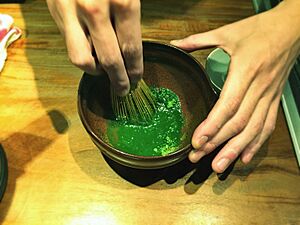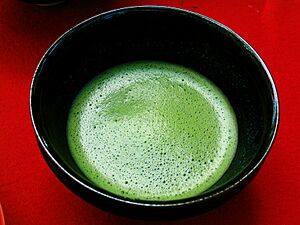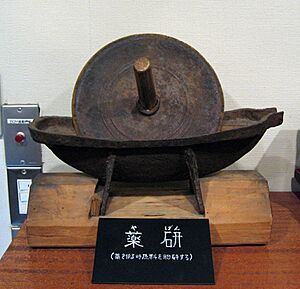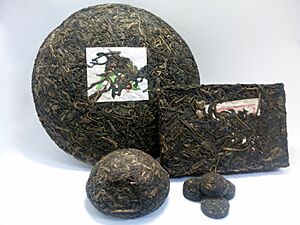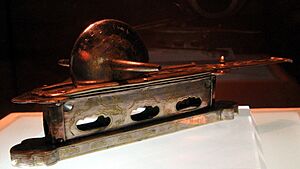Matcha facts for kids
Matcha is a special type of green tea that comes as a very fine powder. It's made from tea leaves grown in the shade, which gives it a bright green color and a rich, savory taste called umami. People usually drink matcha by mixing the powder into hot water.
Matcha first became popular in Japan. Around the 16th century, tea farmers there discovered how to grow tea leaves in the shade. This special way of growing tea is what makes matcha unique. Today, most matcha still comes from Japan. The traditional Japanese tea ceremony, typically known as chanoyu (茶の湯) or sadō/chadō (茶道), centers on the preparation, serving and drinking of matcha as hot tea, and embodies a calm and thoughtful practice.
You can also find matcha in many foods and drinks! It's used to flavor and color things like mochi (a Japanese rice cake), soba noodles, green tea ice cream, matcha lattes, and a variety of Japanese wagashi confectionery. Sometimes, cheaper green tea powder with added color is used for food, instead of the more expensive shade-grown matcha.
Contents
What Makes Matcha Special?
Matcha isn't just any green tea powder. There are clear rules about what can be called "matcha." These rules help make sure you're getting the real thing!
True matcha must be:
- Made from a specific type of tea plant called Camellia sinensis var. sinensis.
- Grown in the shade for a few weeks before harvest.
- Steamed and dried without being rolled.
- Ground into a very fine powder.
The tea leaves used for matcha are shaded for about 2 to 3 weeks before they are picked. This is done using special covers like straw mats or cheesecloth. After the leaves are steamed and dried, but before they are ground, they are called tencha. Sometimes, you might see cheaper green tea powder called "matcha," but it's often made from tea leaves that weren't shade-grown. This type is usually used for flavoring foods.
How Matcha Looks, Tastes, and Smells
Matcha has some very special qualities:
- Color: It's usually a bright, vibrant green. The exact shade can change depending on which leaves are picked.
- Flavor: It has a strong, rich umami taste. Umami is a savory flavor, like what you find in mushrooms or broths.
- Aroma: Matcha has a unique smell, sometimes described as being like green laver (a type of seaweed).
The bright green color comes from the tea plants making more chlorophyll when they grow in the shade. This helps them capture more sunlight. The amazing umami flavor comes from special compounds called amino acids in the tea leaves. Growing the tea in the shade helps keep these amino acids from breaking down, making the flavor even richer. Shading also increases the amount of caffeine in the leaves, but it reduces other compounds called catechins.
How Matcha is Made
Making matcha is a careful process. First, the tencha leaves are steamed for a short time. This steaming makes the leaves soft and stops them from changing color. Then, the leaves are dried in special machines. After drying, the tencha is stored for several months in cool, dry places. Expert tasters then blend the leaves.
Finally, the dried leaves are ground into a super fine powder using a grinding mill. Long ago, people used hand-turned stone mills. Today, machines do the grinding, but they still work slowly in cool rooms. This keeps the tea from getting too hot, which could spoil its quality.
When you drink matcha, it's mixed with hot water. There are two main ways to prepare it:
- Koicha (thick tea): This uses higher-quality matcha and less hot water. It's a thicker, richer drink and isn't foamed.
- Usucha (thin tea): This uses less matcha and more hot water. It's often whisked until it's foamy, which helps make it less bitter.
Matcha in Japanese Tea Ceremonies
The Japanese tea ceremony is a beautiful tradition where matcha plays a central role. Making and drinking koicha is often the main part of the ceremony, while usucha is also enjoyed.
Special tools are used in the ceremony. Matcha is kept in containers called chaki. Before use, the powder is often sifted to remove any lumps. A traditional Japanese spoon called a chashaku is used to scoop the matcha into a chawan (tea bowl). Hot water is added, and then the mixture is whisked with a chasen, which is a whisk usually made from bamboo. The tea is then sipped from the chawan. It's common to eat sweets before drinking matcha to enjoy the tea's flavor even more.
Different Types of Powdered Green Tea
There are a few types of powdered green tea from Japan. Here's how they are different:
| matcha (抹茶) | hunmatsucha (粉末茶) | konacha (粉茶) | instant tea (インスタントティー) | |
|---|---|---|---|---|
| Feature | Tea grown in the shade, steamed, and dried without being rolled and ground to a fine powder | Crushed tea leaves | Powdered tea sieved during the finishing process | Water-soluble solid component extracted from green tea, concentrated, dried, and made into powder |
| How to drink | Drink by mixing with hot water | Drink using a teapot or a tea strainer | Drink tea dissolved in hot water | |
All these teas are made from the Camellia sinensis var. sinensis plant.
Where Matcha is Produced
Most matcha is produced in Japan, where it is highly valued for the Japanese tea ceremony. Some matcha is also produced in China and Vietnam, often for export to Japan.
Other Ways to Enjoy Matcha
Matcha is used in many delicious foods and drinks! You can find it in Japanese sweets like castella cakes, manjū, and monaka. It's also used as a topping for shaved ice (kakigōri) or mixed with salt to flavor tempura (fried foods).
In Western countries, matcha is popular in chocolates, candy, and desserts like cakes, pastries, cookies, pudding, and green tea ice cream. You can even find matcha frozen yogurt! Famous snacks like Pocky and Kit Kat have matcha-flavored versions in Japan.
Matcha drinks have become very popular in cafes like Starbucks. You can find matcha lattes, iced matcha drinks, milkshakes, and smoothies. People enjoy matcha drinks because they are seen as a healthier option with less caffeine than coffee.
The History of Matcha
Matcha's Journey in Japan
Tea first arrived in Japan in the 9th century, brought by a Buddhist monk named Eichū from China. He prepared tea for the Emperor, but it was a different kind of tea back then, likely pressed into bricks.
Powdered Tea Arrives in Japan
Powdered tea, similar to matcha, was brought to Japan in 1191 by another Zen monk named Eisai. He also brought tea seeds and wrote a book about the health benefits of drinking tea. At that time, tea was mostly seen as a medicine. Eisai's methods involved steaming and drying tea leaves, then grinding them into a powder. This early powdered tea was brownish-black, not the bright green we see today.
Eisai's student, Myōe, started tea plantations in areas like Togano'o and Uji in Kyoto. Uji later became one of Japan's most famous tea-producing regions.
Matcha Becomes Popular and Refined
Matcha became very important in Zen monasteries and among the upper classes in Japan from the 14th to 16th centuries. Early powdered tea was a bit rough, but in the 14th century, special stone mills were developed to grind the tea into a much finer powder, making matcha even better.
During the Muromachi period, tea drinking spread. Tea masters like Sen no Rikyū helped create the Japanese tea ceremony as we know it today. This ceremony focused on simplicity and inner peace, rather than showing off expensive items. The idea of wabi-sabi, which finds beauty in simple and imperfect things, became a big part of the tea ceremony.
A key development was growing tea plants in the shade. This technique, which started around the 15th century, helped protect young tea sprouts from frost. It also made the tea leaves brighter green and gave them a unique flavor. By limiting sunlight, the tea leaves kept more of their umami flavor and became more vibrant in color. Before this, powdered tea from China was often brown.
Old Traditions and Modern Changes
In the past, special tea masters in Uji had the exclusive right to grow shaded tea. They supplied high-quality matcha to the shogun and noble families. One famous matcha brand, Baba Mukashi, was named after a skilled tea preparer who served the shogun.
Matcha was often transported in special jars from Uji to Edo (now Tokyo) for the shogun. This journey, called the Ochatsubo Dōchū, was so important that even powerful lords had to make way for the procession!
After the Meiji Restoration in 1868, Japan changed a lot. The old system ended, and the special privileges of the Uji tea masters disappeared. This allowed shaded tea growing techniques to spread to other parts of Japan. New machines were invented to dry tea leaves more efficiently, improving matcha quality.
Today, matcha is still central to the Japanese tea ceremony, taught in schools and workshops. In recent years, matcha has become popular worldwide as a healthy food. People love it for its natural compounds that can help reduce stress and boost brain power. Japanese producers are working hard to share their high-quality matcha with the world.
Matcha's Roots in China
Matcha as we know it today didn't exist in ancient China, but people there did grind tea leaves.
During the Tang dynasty (618–907), tea leaves were steamed and pressed into hard "tea bricks" for storage and trade. People would roast these bricks over a fire, grind them into powder, and then boil the powder with water, sometimes adding salt or spices like ginger and mint.
Powdered Tea in the Song Dynasty
In the Song dynasty (960–1279), powdered tea became very popular. People would whisk the tea powder with hot water in a bowl, much like modern matcha. Famous books from this time describe how to prepare high-quality compressed tea. The tea was ground into powder, sifted, and then whisked with hot water.
However, the ideal color for tea back then was white, not green. To make it white, tea buds were picked very early and processed in special ways.
Why Powdered Tea Changed in China
Making these special lump teas in the Song dynasty was very difficult and expensive. It was not something ordinary people could easily enjoy.
Later, in the Ming dynasty, the emperor Zhu Yuanzhang banned the production of compressed tea in 1391. He felt it was too much work for the people. After this, the way people drank tea in China changed. Instead of grinding tea into powder, they started steeping loose tea leaves in hot water, which is how many people drink tea today.
So, while powdered tea faded away in China, the tradition was kept alive in Japan. Through new ideas like shade cultivation and stone-milling, Japan developed the unique green tea we now call matcha.
Images for kids
-
Matcha ice cream at a restaurant in Tokyo
-
Matcha tiramisu
-
Coffee bean chocolate matcha in Maitum
See also
 In Spanish: Té matcha para niños
In Spanish: Té matcha para niños
- Green tea
- Food powder
- Tea culture in Japan



